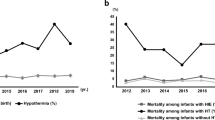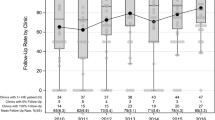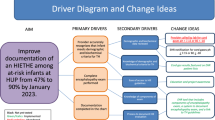Abstract
Objective
Evaluate the changes in management and outcomes of Californian infants with hypoxic ischemic encephalopathy (HIE).
Study design
Infants with HIE were identified from a California administrative birth cohort using ICD codes and divided into two epochs, Epoch 1 (2010–2015) and Epoch 2 (2016–2019). Risk ratios (RR) for induced hypothermia (IH) in each epoch and their outcomes were calculated using log-linear regression.
Results
In this cohort, 4779 infants with HIE were identified. Incidence of HIE in California increased yearly from 0.5/1000 California births to a peak of 1.5/1000 births in 2018. The use of IH in infants with mild HIE increased in Epoch 2 compared to Epoch 1. There was no significant difference in outcomes between epochs for infants with mild HIE that received IH including no difference in neonatal seizures.
Conclusion
Significantly more infants with mild HIE received IH since 2015 in California, but no significant difference in outcomes.
This is a preview of subscription content, access via your institution
Access options
Subscribe to this journal
Receive 12 print issues and online access
$259.00 per year
only $21.58 per issue
Buy this article
- Purchase on SpringerLink
- Instant access to full article PDF
Prices may be subject to local taxes which are calculated during checkout

Similar content being viewed by others
Data availability
All analyses were performed using Statistical Analysis Software version 9.4 (Cary, NC) with code available upon request.
References
Douglas-Escobar M, Weiss MD. Hypoxic-ischemic encephalopathy: a review for the clinician. JAMA Pediatr 2015;169:397–403. https://doi.org/10.1001/jamapediatrics.2014.3269
Allen KA, Brandon DH. Hypoxic ischemic encephalopathy: pathophysiology and experimental treatments. Newborn Infant Nurs Rev 2011;11:125–33. https://doi.org/10.1053/j.nainr.2011.07.004
Sarnat HB, Sarnat MS. Neonatal encephalopathy following fetal distress: a clinical and electroencephalographic study. Arch Neurol 1976;33:696–705. https://doi.org/10.1001/archneur.1976.00500100030012
Murray DM, OConnor CM, Ryan CA, Korotchikova I, Boylan GB. Early EEG grade and outcome at 5 years after mild neonatal hypoxic ischemic encephalopathy. Pediatrics 2016;138:e20160659. https://doi.org/10.1542/peds.2016-0659
Shankaran S, Laptook AR, Ehrenkranz RA, Tyson JE, McDonald SA, Donovan EF, et al. Whole-body hypothermia for neonates with hypoxic-ischemic encephalopathy. N Engl J Med. 2005;353:1574–84. https://doi.org/10.1056/NEJMcps050929
Shankaran S, Pappas A, Laptook AR, McDonald SA, Ehrenkranz RA, Tyson JE, et al. Outcomes of safety and effectiveness in a multicenter randomized, controlled trial of whole-body hypothermia for neonatal hypoxic-ischemic encephalopathy. Pediatrics 2008;122:e791–8.
Azzopardi D, Brocklehurst P, Edwards D, Halliday H, Levene M, Thoresen M, et al. The TOBY Study. Whole body hypothermia for the treatment of perinatal asphyxial encephalopathy: a randomised controlled trial. BMC Pediatr 2008;8:17. https://doi.org/10.1186/1471-2431-8-17. Published 2008 Apr 30.
Hoehn T, Hansmann G, Bührer C, Simbruner G, Gunn AJ, Yager J, et al. Therapeutic hypothermia in neonates. Review of current clinical data, ILCOR recommendations and suggestions for implementation in neonatal intensive care units. Resuscitation 2008;78:7–12. https://doi.org/10.1016/j.resuscitation.2008.04.027
Shah PS. Hypothermia: a systematic review and meta-analysis of clinical trials. Semin Fetal Neonatal Med. 2010;15:238–46. https://doi.org/10.1016/j.siny.2010.02.003
Massaro AN, Murthy K, Zaniletti I, Cook N, DiGeronimo R, Dizon M, et al. Short-term outcomes after perinatal hypoxic ischemic encephalopathy: a report from the Children’s Hospitals Neonatal Consortium HIE focus group. J Perinatol. 2015;35:290–6. https://doi.org/10.1038/jp.2014.190
Chalak LF, Nguyen KA, Prempunpong C, Heyne R, Thayyil S, Shankaran S, et al. Prospective research in infants with mild encephalopathy identified in the first six hours of life: neurodevelopmental outcomes at 18-22 months. Pediatr Res. 2018;84:861–8. https://doi.org/10.1038/s41390-018-0174-x
Thayyil S, Pant S, Montaldo P, Shukla D, Oliveira V, Ivain P, et al. Hypothermia for moderate or severe neonatal encephalopathy in low-income and middle-income countries (HELIX): a randomised controlled trial in India, Sri Lanka, and Bangladesh. Lancet Glob Health 2021;9:e1273–e1285. https://doi.org/10.1016/S2214-109X(21)00264-3
Laptook AR, Shankaran S, Faix RG. Hypothermia for hypoxic-ischemic encephalopathy Second-generation trials address gaps knowledge. Clin Perinatol. 2024;51:587–603. https://doi.org/10.1016/j.clp.2024.04.014
Montaldo P, Cirillo M, Burgod C, Caredda E, Ascione S, Carpentieri M, et al. Whole-body hypothermia vs targeted normothermia for neonates with mild encephalopathy: a multicenter pilot randomized clinical trial. JAMA Netw Open 2024;7:e249119. https://doi.org/10.1001/jamanetworkopen.2024.9119
Bandoli G, Suttner D, Kiernan E, Baer RJ, Jelliffe-Pawlowski L, Chambers CD. Risk factors for neonatal encephalopathy in late preterm and term singleton births in a large California birth cohort. J Perinatol 2022;42:341–7. https://doi.org/10.1038/s41372-021-01242-z
Wu YW, Comstock BA, Gonzalez FF, Mayock DE, Goodman AM, Maitre NL, et al. Trial of erythropoietin for hypoxic-ischemic encephalopathy in newborns. N Engl J Med. 2022;387:148–59. https://doi.org/10.1056/NEJMoa2119660
Gluckman PD, Wyatt JS, Azzopardi D, Ballard R, Edwards AD, Ferriero DM, et al. Selective head cooling with mild systemic hypothermia after neonatal encephalopathy: multicentre randomised trial. Lancet 2005;365:663–70. https://doi.org/10.1016/S0140-6736(05)17946-X
Azzopardi DV, Strohm B, Edwards AD, Dyet L, Halliday HL, Juszczak E, et al. Moderate hypothermia to treat perinatal asphyxial encephalopathy. N Engl J Med. 2009;361:1349–58. https://doi.org/10.1056/NEJMoa0900854
Laptook A, Tyson J, Shankaran S, McDonald S, Ehrenkranz R, Fanaroff A, et al. Elevated temperature after hypoxic-ischemic encephalopathy: risk factor for adverse outcomes. Pediatrics 2008;122:491–9. https://doi.org/10.1542/peds.2007-1673
Dankiewicz J, Cronberg T, Lilja G, Jakobsen JC, Levin H, Ullén S, et al. Hypothermia versus normothermia after out-of-hospital cardiac arrest. N Engl J Med. 2021;384:2283–94. https://doi.org/10.1056/NEJMoa2100591
Moler FW, Silverstein FS, Holubkov R, Slomine BS, Christensen JR, Nadkarni VM, et al. Therapeutic hypothermia after out-of-hospital cardiac arrest in children. N Engl J Med 2015;372:1898–908. https://doi.org/10.1056/NEJMoa1411480
Committee on Fetus and Newborn, Papile LA, Baley JE, Benitz W, Cummings J, Carlo WA, et al. Hypothermia and neonatal encephalopathy. Pediatrics 2014;133:1146–50. https://doi.org/10.1542/peds.2014-0899
Kumar V, Singla M, Thayyil S. Cooling in mild encephalopathy: Costs and perils of therapeutic creep. Semin Fetal Neonatal Med 2021;26:101244. https://doi.org/10.1016/j.siny.2021.101244
Sekhar MS, Vyas N. Defensive medicine: a bane to healthcare. Ann Med Health Sci Res 2013;3:295–6. https://doi.org/10.4103/2141-9248.113688
Garattini L, Padula A. Defensive medicine in Europe: a ‘full circle’?. Eur J Health Econ. 2020;21:165–70. https://doi.org/10.1007/s10198-019-01144-0
Miziara ID, Miziara CSMG. Medical errors, medical negligence and defensive medicine: A narrative review. Clinics 2022;77:100053. https://doi.org/10.1016/j.clinsp.2022.100053. Published 2022 May 28.
Yan SC, Hulou MM, Cote DJ, Roytowski D, Rutka JT, Gormley WB, et al. International defensive medicine in neurosurgery: comparison of Canada, South Africa, and the United States. World Neurosurg 2016;95:53–61. https://doi.org/10.1016/j.wneu.2016.07.069
El-Dib M, Inder TE, Chalak LF, Massaro AN, Thoresen M, Gunn AJ. Should therapeutic hypothermia be offered to babies with mild neonatal encephalopathy in the first 6 h after birth? Pediatr Res 2019;85:442–8. https://doi.org/10.1038/s41390-019-0291-1
Therapeutic Hypothermia for Neonatal Encephalopathy a Framework for Practice November 2020. https://hubble-live-assets.s3.eu-west-1.amazonaws.com/bapm/file_asset/file/10/TH_document_for_publication.pdf
Cooling in Mild Encephalopathy (COMET) trial. Imperial College London. Accessed July 15, 2024. https://www.imperial.ac.uk/perinatal-neuroscience/current-research/comet-trial/
COOL PRIME Study. www.coolprime.org. Accessed July 15, 2024. https://www.coolprime.org/
Kracer B, Hintz SR, Van Meurs KP, Lee HC. Hypothermia therapy for neonatal hypoxic ischemic encephalopathy in the state of California. J Pediatr 2014;165:267–73. https://doi.org/10.1016/j.jpeds.2014.04.052
Acknowledgements
We would like to thank the Study of Mothers and Infants Research Group for their assistance. This study was supported by the San Diego Study of Mothers and Infants at the University of California San Diego and by the Rady Children’s Institute for Genomic Medicine. The data in this manuscript has been previously presented at: Western Society for Pediatric Research Conference, January 2023, Podium presentation. Cool Topics in Neonatology Conference, March 2023, Poster presentation. Pediatric Academic Societies Conference, May 2024, Poster presentation. The data in this manuscript has not been previously published or submitted for publication.
Funding
Gretchen Bandoli is funded by a NIH award (K01 AA027811) and the Rady Children’s Institute for Genomic Medicine.
Author information
Authors and Affiliations
Contributions
Carolyn Fall formulated the research question, designed the study, and drafted the manuscript. Rebecca J. Baer performed the statistical analysis for this study. Gretchen Bandoli provided mentorship expertise on study design and manuscript editing. Henry C. Lee and Christina D. Chambers provided expertise in epidemiology, hypoxic ischemic encephalopathy, and manuscript editing.
Corresponding author
Ethics declarations
Competing interests
The authors declare no competing interests.
Additional information
Publisher’s note Springer Nature remains neutral with regard to jurisdictional claims in published maps and institutional affiliations.
Supplementary information
Rights and permissions
Springer Nature or its licensor (e.g. a society or other partner) holds exclusive rights to this article under a publishing agreement with the author(s) or other rightsholder(s); author self-archiving of the accepted manuscript version of this article is solely governed by the terms of such publishing agreement and applicable law.
About this article
Cite this article
Fall, C., Baer, R.J., Lee, H.C. et al. Changes in the treatment and outcomes of different severities of neonatal hypoxic ischemic encephalopathy in California: a retrospective cohort study. J Perinatol 45, 1064–1072 (2025). https://doi.org/10.1038/s41372-025-02212-5
Received:
Revised:
Accepted:
Published:
Issue date:
DOI: https://doi.org/10.1038/s41372-025-02212-5



